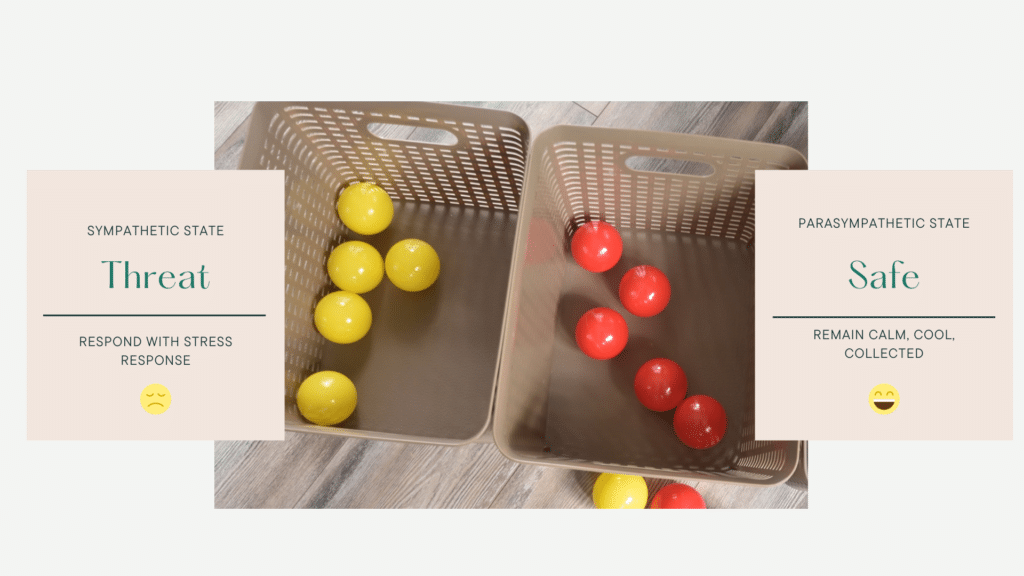Are you a working mom feeling exhausted, struggling to sleep, and finding yourself moody and dealing with weight issues? If so, you’re not alone.
A body that’s stuck in a stress response, or something we call “fight or flight” can leave you feeling lots of seemingly random symptoms.
You might push through these symptoms, self-medicate, or have even gone to your doctor to try and get answers and relief, but the answer has been you’re normal and this is what happens when we age. (Spoiler alert, it’s not!)
Do you experience any of these?
✅ tightness in your chest or throat
✅ restlessness / inability to sit still
✅ digestive issues / changes in appetite
✅ shoulder / neck / back tension
✅ insomnia or unrestful sleep
✅ constant fatigue
✅ excessive sweating or trembling
✅ shortness of breath
✅ heart pounding
✅ dizziness / lightheadedness
✅ muscle tension
✅ weight gain
✅ acne / skin flare ups
✅ puffy face
✅ craving salt / sugar
✅ hair falling out
✅ drinking lots of coffee to get thru the day
✅ severe fatigue
✅ difficulty concentrating / racing thoughts
✅ difficulty resting
✅ muscle weakness
✅ gut issues
✅ bloating
Many people experience these feelings and symptoms, often without understanding the underlying reasons—a body that’s stuck in a stress response.
In this post, we’ll break down what we mean when we say “fight or flight” and “rest and digest,” and offer tips on how to move from one state to the other, including using our app filled with somatic tools to help move your body into a state of calm.
Understanding Fight or Flight and Rest and Digest
The Sympathetic and Parasympathetic Nervous Systems

Our bodies are equipped with two primary nervous system states that help us respond to different situations: the sympathetic nervous system (SNS) and the parasympathetic nervous system (PNS).
Fight or Flight: The Sympathetic Nervous System (SNS)
Often referred to as the “fight or flight” system, the SNS prepares your body to respond to perceived threats.
It’s an ancient survival mechanism designed to protect you in dangerous situations by increasing your heart rate, redirecting blood flow to your muscles, and releasing stress hormones like adrenaline so you can actively fight the danger in front of you, or run away so you can live to see another day.
Rest and Digest: Parasympathetic Nervous System (PNS)
Known as the “rest and digest” or “rest and repair” system, the PNS is activated when your body relaxes and recuperates.
It slows your heart rate, promotes digestion, and encourages restful sleep. This state is essential for overall well-being and recovery.
In fact, you can only heal and repair your body in this state, so it’s essential to be in this state for most of your day!
What It Feels Like to Be in Fight or Flight
When you’re in a fight or flight state, you might experience:
👉 Increased Heart Rate: Your heart pounds as it pumps more blood to your muscles.
👉 Rapid Breathing: Your breathing quickens to supply more oxygen to your body.
👉 Tense Muscles: Your muscles tighten, ready for action.
👉 Sweating: Your body sweats more to cool down.
👉 Hypervigilance: You’re on high alert, ready to react to any perceived threat.
👉 Difficulty Sleeping: Your body’s heightened state makes it hard to wind down.
👉 Digestion Issues: Your body turns off digestion when you’re stressed so it can run and fight instead of digesting food.
👉 Low Libido: A body that’s on high alert and feels unsafe is also de-prioritizing sex and reproduction.
👉 Irritability: Your body is maxed out looking for dangers and running low on reserves because it hasn’t had a chance to repair itself in a while.
👉 Irrational decision making: The prefrontal cortex, where logic happens, goes offline and the primal limbic system takes over.
👉 Brain Fog: Without sleep and the constant push of adrenaline, the brain operates from the limbic system and you have a hard time recalling words and objects.

What It Feels Like to Be in Rest and Digest
Conversely, when you’re in a rest and digest state, you may notice:
🎉 Calm Heart Rate: Your heart beats at a steady, relaxed pace.
🎉 Deep, Slow Breathing: Your breaths are deep and steady, promoting relaxation.
🎉 Muscle Relaxation: Your muscles feel loose and relaxed.
🎉 Regular Digestion: Your digestive system works efficiently.
🎉 Sense of Calm: You feel peaceful and content.
🎉 Better Sleep: You can fall asleep more easily and enjoy restful sleep.
🎉 Laughing and feeling joy: You’re able to relax and take things less seriously.
🎉 Better skin, nails, and hair: Your body is able to make new cells.
What Is Nervous System Dysregulation?
Regulation is the term we use for when things are in balance and working properly. They are “regular.”
Nervous system dysregulation happens when the balance between the sympathetic and parasympathetic nervous systems is off.
Think of your body like a bank. If you make too many withdrawals and not enough deposits, you’re going to incur an overdraft fee.
All your symptoms are overdraft fees.
The more you continue to make withdrawals and only small deposits that barely make a dent makes it hard for the body to handle stress and relax properly.
Understanding nervous system dysregulation and learning the tools to help you get back into balance is important for feeling better and staying healthy.

Tips to Move from Fight or Flight to Rest and Digest
Making the transition from a state of fight or flight to rest and digest is crucial for your health and well-being. Here are some tips to help you achieve this:
1. Practice Deep Breathing
Deep breathing exercises can activate the PNS, helping to calm your nervous system. Try inhaling deeply through your nose, holding for a few seconds, and then exhaling slowly through your mouth. Make your exhale twice as long as your inhale.
Repeat a few times until you feel better.
2. Get morning and evening sunlight
This one seems both obvious and strange at the same time. Your eyes are part of your nervous system and when they see earling morning and evening sun, it helps to regulate and set the melatonin for the day. This ensures you can have a good night sleep while also giving your body the vitamins it needs from the sun.
3. Physical Exercise
Regular physical activity can help release built-up tension and promote relaxation. Even a short walk can make a significant difference. If you take your walks after you eat you get the double bonus of regulating your blood sugar.
4. Use the Your Daily® Nervous System Coaching App
The Your Daily® Nervous System Coaching app is packed with somatic tools designed to help you calm your nervous system.
From somatic movements, journaling prompts, to guided meditations and breathing exercises, it offers a variety of resources to support your transition from fight or flight to rest and digest.
5. Journal
Journaling can be an incredibly effective tool for moving out of the fight or flight state and into a more relaxed and balanced state of being. When you journal, you create a space to process your thoughts and emotions, which can help release stuck energy and relax the body.
6. Connect with Loved Ones
We make oxytocin when we’re stressed because it’s the bonding hormone. You are literally wired to seek out comfort in friends and family when you’re feeling stressed. Spending time with family and friends can provide emotional support and help you feel more relaxed.
Conclusion
Understanding the difference between the fight or flight and rest and digest states is the first step toward managing stress and improving your overall well-being.
By learning to recognize these states and using the tips provided, you can better manage your nervous system and lead a healthier, more balanced life.
Ready to take control of your nervous system and enhance your well-being? Download the Your Daily® Nervous System Regulation app today and explore the somatic tools available to help you transition from fight or flight to rest and digest. It’s available in both the Google Play store and Apple App Store.
Remember, you’re not alone in this. We’re here to support you every step of the way.





